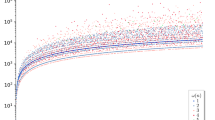Abstract
We study the equivalence between the ring learning with errors and polynomial learning with errors problems for cyclotomic number fields, namely: we prove that both problems are equivalent via a polynomial noise increase as long as the number of distinct primes dividing the conductor is kept constant. We refine our bound in the case where the conductor is divisible by at most three primes and we give an asymptotic subexponential formula for the condition number of the attached Vandermonde matrix valid for arbitrary degree.
Similar content being viewed by others
Notes
At https://www.safecrypto.eu/pqclounge/ a summary of candidates and the history of all submissions, attacks and withdrawals is available to filter and check.
This is the definition of RLWE/PLWE in search version. As all this material is nowadays well known to the specialist we are sparing as many details as possible. We are taking this version as starting point, as it is more suitable for our argument. We refer the reader to [10] for the decisional version of the problem.
For \(p(x)=\displaystyle \sum _{i=0}^np_ix^i\in {\mathbb {R}}[x]\), the 1-norm is defined as \(||p||_1=\displaystyle \sum _{i=0}^n|p_i|\)
References
Bang, A.S.: Om ligningen \(\Phi _m(X)=0\). Afdeling B, Nyt tidsskrift for Matematik 6, 6–12 (1895)
Bateman, P.T.: Note on the coefficients of cyclotomic polynomials. Bull. Am. Math. Soc. 55(12), 1180–1181 (1949)
Bateman, P.T.: On the size of the coefficients of the cyclotomic polynomial. Seminaire de Théorie des Nombres de Bordeaux 11(28), 1–18 (1982)
Bernstein, D.J., Chuengsatiansup, C., Lange, T., van Vredendaal, C.: NTRU Prime (2016). http://eprint.iacr.org/2016/461. Accessed 27 Apr 2020
Bloom, D.M.: On the coefficients of the cyclotomic polynomial. Am. Math. Mon. 75(4), 372–377 (1968)
Boas, P.E.: Another NP-Complete Problem and the Complexity of Computing Short Vectors in a Lattice. Technical Report 81-04, Mathematische Instituut, University of Amsterdam (1981)
Ducas, L., Durmus, A.: Ring-LWE in polynomial rings. In: PKC (2012)
Erdös, P.: On the coefficients of the cyclotomic polynomial. Portugaliae Mathematica 8(2), 63–71 (1949)
Gautschi, W., Inglese, G.: Lower bounds for the condition number of Vandermonde matrices. Numerische Mathematik 52, 241–250 (1988)
Lyubashevsky, V., Peikert, C., Regev, O.: On ideal lattices and learning with errors over rings. In: Gilbert H. (eds) Advances in Cryptology EUROCRYPT 2010. Lecture Notes in Computer Science, 6110. Springer, Berlin
Maier, H.: Cyclotomic polynomials with large coefficients. Acta arithmetica 64(3), 227–235 (1993)
Pan, V.Y.: How bad are Vandermonde matrices? SIAM J. Matrix Anal. Appl. 37(2), 679–694 (2016)
Peikert, C., Regev, O., Stephens-Davidowitz, N.: Pseudorandomness of Ring-LWE for any ring and modulus. In: STOC (2017)
Regev, O.: On lattices, learning with errors, random linear codes and cryptography. J. ACM 56(6), 34 (2009)
Rosca, M., Stehlé, D., Wallet, A.: On the ring-LWE and polynomial-LWE problems. In: Nielsen J., Rijmen V. (eds) Advances in Cryptology EUROCRYPT 2018. Lecture Notes in Computer Science, vol. 10820. Springer, Berlin
Stehle, D.N., Steinfeld, R., Tanaka, K., Xagawa, K.: Efficient public key encryption based on ideal lattices. Adv. Cryptol. ASIACRYPT 2009, 617–635 (2009)
Stewart, I.: Algebraic Number Theory and Fermat’s Last Theorem. AK Peters Ltd, Natick (2002)
Vaughan, R.C.: Bounds for the coefficients of cyclotomic polynomials. Michigan Math. J. 21(4), 289–295 (1975)
Washington, L.C.: Introduction to Cyclotomic Fields. Springer GTM, Berlin (1997)
Acknowledgements
Partially supported by MTM2016-79400-P.
Author information
Authors and Affiliations
Corresponding author
Additional information
Publisher's Note
Springer Nature remains neutral with regard to jurisdictional claims in published maps and institutional affiliations.
Rights and permissions
About this article
Cite this article
Blanco-Chacón, I. On the RLWE/PLWE equivalence for cyclotomic number fields. AAECC 33, 53–71 (2022). https://doi.org/10.1007/s00200-020-00433-z
Received:
Revised:
Accepted:
Published:
Issue Date:
DOI: https://doi.org/10.1007/s00200-020-00433-z




